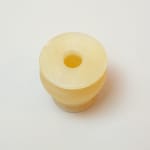Middle Kingdom Alabaster Jar, 2200 BCE - 1800 BCE
Alabaster
4.4 x 4.3 cm
1 3/4 x 1 5/8 in
1 3/4 x 1 5/8 in
CK.0194
Alabaster is a fine-grained, massive, translucent variety of gypsum, a hydrous calcium sulphate. Alabaster occurs naturally in many shades of color, from pure white to reddish-tan. Like all other forms...
Alabaster is a fine-grained, massive, translucent variety of gypsum, a hydrous calcium sulphate. Alabaster occurs naturally in many shades of color, from pure white to reddish-tan. Like all other forms of gypsum, alabaster forms by the evaporation of bedded deposits that are precipitated mainly from evaporating seawater. Indigenous to Egypt, alabaster has been quarried for more than seven thousand years from a source just a few miles behind the Valley of the Kings in ancient Thebes. This stone was prized by the pharaohs for its luminous properties. When held up to the light, the stone absorbs the glow and spreads it evenly throughout its structure, becoming almost translucent if carved thinly enough. The Ancient Egyptians used this wonderful material for many purposes, including household items, ritual objects, and for a number of different funerary uses such as sarcophagi and canopic jars.
Egyptian alabaster vessels were owned by the wealthy, served as royal paraphernalia for ritual libations and for the storage of oils, ointment, cosmetics and other costly substances. The small size of this vessel suggests that it once held expensive and precious materials befitting such a luxurious container.
Egyptian alabaster vessels were owned by the wealthy, served as royal paraphernalia for ritual libations and for the storage of oils, ointment, cosmetics and other costly substances. The small size of this vessel suggests that it once held expensive and precious materials befitting such a luxurious container.



